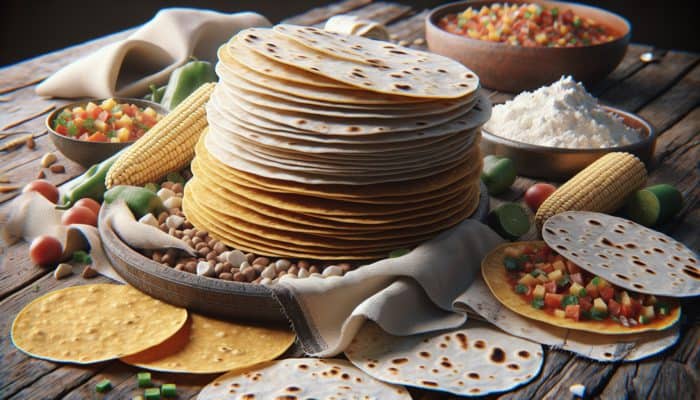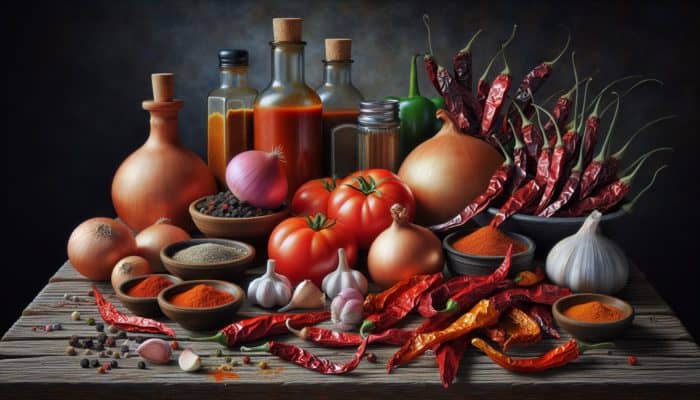Key Ingredients for Making Authentic Enchiladas That Impress
Selecting the Ideal Tortillas for Flavorful Enchiladas

To create authentic Mexican enchiladas, your first step is to select the perfect tortillas. Traditionally, corn tortillas are favored for their distinct flavor and texture, contributing an earthy and rich essence to the dish. On the other hand, flour tortillas are increasingly popular in certain regions, particularly among those who prefer a softer and chewier texture. The decision between these two types hinges on personal preferences and dietary needs. For instance, corn tortillas are gluten-free and provide an authentic taste, while flour tortillas can hold more filling and are generally less prone to tearing during the rolling process. When selecting your tortillas, consider nutritional value, dietary restrictions, and the texture you aspire to achieve in your enchiladas.
Freshness is a critical factor; always opt for locally made tortillas or, even better, make your own using masa harina. The quality of the tortillas you choose can significantly influence the overall enchilada experience. If opting for store-bought options, closely examine the ingredient list for authenticity—ideally, they should contain only corn, water, and lime. This simple ingredient profile guarantees a taste that aligns with traditional Mexican cuisine.
Choosing the Best Cheese to Enhance Your Enchiladas
The type of cheese you incorporate into your enchiladas can elevate the dish from ordinary to extraordinary. Common choices include queso fresco, which is crumbled on top to provide a creamy and salty contrast, cheddar for a sharp flavor, and Monterey Jack, celebrated for its exceptional melting qualities. Each cheese contributes a unique flavor profile, enhancing the overall taste experience of your meal. When selecting cheese, consider both its flavor and meltability, as these attributes significantly affect the texture and enjoyment of the dish.
For a genuinely rich experience, look for artisanal cheeses produced through traditional methods, as they may utilize local ingredients or specific regional techniques, deepening your connection to Mexico’s culinary heritage. Don’t hesitate to experiment with a combination of different cheeses; blending varieties can create complex flavors, allowing you to discover delightful combinations that tantalize your taste buds.
Diverse Protein Choices for Your Enchiladas
Enchiladas are incredibly versatile, offering a myriad of protein options to accommodate various dietary preferences. Traditional fillings often feature seasoned shredded chicken or beef, which can be enhanced with an array of spices to amplify their flavor. If you’re pursuing vegetarian alternatives, consider incorporating beans, lentils, or a medley of sautéed vegetables such as zucchini, bell peppers, and mushrooms. These choices not only provide nutritional balance but also enrich the overall flavor profile of the dish.
Regional variations can influence protein selections as well. For instance, in coastal areas, seafood like shrimp or fish is frequently featured, adding a refreshing twist to the classic recipe. When choosing your protein, pay attention to how the flavors will harmonize with your sauce and toppings to ensure a cohesive dish. Additionally, the method of preparation matters; slow-cooked meats can absorb spices and moisture, while grilling vegetables can enhance their natural sweetness, ensuring every bite is a delightful experience.
Choosing the Perfect Sauce to Elevate Your Enchiladas

The sauce stands as one of the most vital components of any enchilada dish, with red and green chili sauces being the traditional favorites. A red sauce, typically made from dried red chilies, contributes a rich, smoky flavor that tantalizes the taste buds. In contrast, a green sauce, generally crafted from tomatillos or green chilies, offers a tangy and refreshing taste. Your choice should align with the flavor profile you desire, as each sauce can dramatically alter the dining experience.
Pay close attention to the heat level of your sauce; some chilies are milder than others, and pairing the right sauce with your protein can either amplify or dampen specific flavors. A well-balanced sauce should complement the protein without overpowering it. When preparing your sauce, taste frequently and adjust the seasoning and heat according to your preference. An overly spicy sauce can overshadow other ingredients, while a bland sauce might leave your dish lacking in depth and character.
Fresh Toppings and Garnishes for an Unforgettable Enchiladas Experience
Enhancing your enchiladas with fresh toppings and garnishes is essential for elevating the dish to new heights. Ingredients such as finely chopped onions, fresh coriander, and a squeeze of lime deliver a burst of brightness and flavor that can significantly enhance the dish. Moreover, creamy elements like sour cream or avocado add a rich contrast to the spiciness of the enchiladas. These toppings not only amplify the flavor but also introduce a textural contrast that makes each bite enjoyable.
When selecting your garnishes, aim for a balance of textures and tastes. A sprinkle of crumbled queso fresco can add creaminess, while diced tomatoes can provide a juicy crunch. Tailoring these elements to your preferences can transform simple enchiladas into a stunning dish. Feel free to experiment with various garnishing techniques, whether it’s a drizzle of crema for added richness or a scattering of pomegranate seeds for a vibrant splash of color and sweetness.
Mastering the Craft of Enchilada Sauce Preparation
Key Ingredients for Authentic Enchilada Sauce Creation

The heart of any genuine enchilada lies within its sauce. A traditional enchilada sauce typically consists of fundamental ingredients like tomatoes, dried chilies, garlic, and an assortment of spices. The tomatoes provide a rich base, while the chilies infuse heat and complexity. Selecting the right type of chili is crucial; options such as ancho, guajillo, or chipotle can introduce layers of flavor, ranging from sweet and smoky to spicy and bold.
Garlic and onions play essential roles in crafting a flavorful foundation, injecting aromatic qualities that elevate the sauce. Spices like cumin, oregano, and a hint of cinnamon can provide depth and balance to the overall flavor profile. Adjust the heat level to your liking by managing the quantity and type of chilies used. The beauty of crafting your sauce lies in its flexibility; feel free to experiment with ingredient ratios until you discover the perfect balance that excites your taste buds and complements your enchiladas beautifully.
Effective Cooking Techniques for Achieving Ideal Sauce Consistency
Achieving the perfect sauce consistency depends greatly on the cooking techniques you employ. Two primary methods—simmering and blending—each offer unique advantages. Simmering allows flavors to meld, resulting in a rich, cohesive sauce. This slow-cook approach helps to soften the chilies, making them easier to blend, while simultaneously concentrating their flavors and enhancing the overall taste.
Alternatively, blending the sauce can yield a smooth and creamy texture, ideal for those who prefer a more refined finish. If using dried chilies, toasting them lightly in a dry skillet before adding them to the sauce can amplify their flavor. The choice between simmering and blending ultimately depends on the texture you desire; for a chunky sauce, prolonged simmering is ideal, while a quick blend can create a smoother consistency. Regardless of your method, always taste and adjust the seasoning throughout the cooking process to ensure maximum flavor and satisfaction.
Proven Methods for Thickening Your Enchilada Sauce
To achieve the desired thickness for your enchilada sauce, there are several effective methods to thicken the sauce. Here are some tried-and-true techniques:
- Roux: A combination of flour and fat cooked together creates a thick base.
- Reduction: Simmering the sauce uncovered allows excess liquid to evaporate, naturally thickening it.
- Cornstarch Slurry: Mixing cornstarch with water and incorporating it into the simmering sauce can quickly thicken it.
- Mashed Beans: Blending pureed beans into the sauce adds body and creaminess.
- Vegetable Puree: Adding pureed cooked vegetables like potatoes or squash can also enrich and thicken the sauce.
- Chia Seeds: Ground chia seeds can absorb liquid and thicken the sauce without altering its flavor.
Experimenting with these techniques allows you to find the perfect thickness that aligns with your taste preferences. Always remember to add thickeners gradually, allowing the sauce time to adjust before adding more, ensuring a delightful final product.
Mastering the Art of Enchilada Assembly
Layering Tortillas for Optimal Flavor and Texture
The assembly process of your enchiladas is crucial for ensuring each bite is packed with flavor and texture. Begin by spreading a generous base layer of sauce in your baking dish—this not only prevents sticking but also infuses the tortillas with rich flavor. Briefly soak each tortilla in the sauce to soften it, making it easier to roll. Proper layering is essential; start with a tortilla, followed by a portion of your protein filling and a sprinkle of cheese. Fold it tightly to securely encase the filling.
Repeat this process for additional layers as desired, but be cautious not to overfill, as this can lead to a messy final product. The key is to find a balance between filling and tortilla, ensuring each enchilada retains its shape while bursting with flavor. Depending on your preferences, you may also wish to alternate fillings for a more diverse flavor experience throughout the dish.
Best Practices for Rolling Enchiladas Successfully
Properly rolling enchiladas is vital for maintaining their structure during baking. To roll enchiladas effectively, tightly wrap the tortilla around the filling, ensuring it remains sealed throughout the cooking process. Use a spoon to guide the filling, preventing it from escaping. Start by placing the filling towards one end of the tortilla, leaving space on the sides to avoid overflow.
- Warm the tortillas to enhance pliability.
- Use a spoon to scoop the filling and position it towards the end of the tortilla.
- Fold in the sides before rolling to secure the filling.
- Roll tightly, but not excessively so, to avoid tearing.
As you roll, keep the edges tucked to ensure a neat appearance. If you find that your tortillas frequently tear or break, consider lightly frying them in oil for a few seconds to enhance their flexibility. This technique also adds a delightful flavor and texture to the final dish, ensuring your enchiladas are both beautiful and delicious.
Topping and Baking Your Enchiladas to Perfection
Once your enchiladas are assembled, it’s time to top and bake them. Generously coat the rolled enchiladas with your chosen sauce, allowing them to absorb flavors and preventing them from drying out in the oven. After applying the sauce, sprinkle a generous amount of cheese on top; this will melt beautifully during baking, creating a deliciously inviting crust.
Preheat your oven to a moderate temperature, typically around 180°C (350°F). Bake the enchiladas until the cheese is melted and bubbly, usually for 20-25 minutes. For a golden finish, consider broiling briefly at the end—watch closely to prevent burning. The end result should be enchiladas that are thoroughly heated, with a perfectly melted cheese topping that beckons you to indulge in a satisfying meal.
Serving and Garnishing Enchiladas for a Stunning Presentation
The way you present your enchiladas can significantly enhance the dining experience. Once out of the oven, allow them to cool slightly before serving. This resting period allows the flavors to settle and facilitates easier plating. Garnish with freshly chopped coriander, diced tomatoes, and a dollop of sour cream for added richness. A squeeze of lime over the top can brighten the dish, accentuating the flavors of the sauce and fillings.
Consider the overall composition of the dish—how the colors and textures of the garnishes complement the enchiladas. A vibrant presentation not only stimulates the appetite but also showcases the effort invested in creating the meal. Whether it’s a casual family dinner or a festive gathering, the way you serve enchiladas can leave a lasting impression on your guests.
Expert Insights on Cooking Authentic Mexican Enchiladas
Real-Life Examples of Delicious Enchilada Recipes
Real-world examples provide a wealth of inspiration for crafting delectable enchiladas. Many chefs and home cooks share their unique recipes, highlighting ingredient combinations that appeal to diverse audiences. For instance, a popular recipe features a spicy chicken filling paired with a creamy green sauce, while another showcases a rich beef filling complemented by a robust red sauce. These examples illustrate the adaptability of enchiladas and their capacity to cater to varying palates and cultural influences.
- Chicken enchiladas with tomatillo sauce.
- Black bean and cheese enchiladas with mole sauce.
- Seafood enchiladas drizzled with a spicy red sauce.
- Vegetarian enchiladas filled with roasted vegetables and green sauce.
These showcased recipes not only inspire creativity but also demonstrate how traditional flavors can be reimagined to suit contemporary tastes. The key lies in using quality ingredients and respecting traditional preparation methods while allowing room for personal touches. When sharing your culinary creations, consider documenting the process with photos or videos to inspire others on their culinary journeys.
Actionable Steps for Amplifying Flavors in Your Enchiladas
To elevate your enchiladas, focus on specific steps for flavor enhancement. Start by marinating your proteins with spices, herbs, or citrus for several hours before assembly. This allows the flavors to infuse into the meat, resulting in a richer taste. Additionally, aim to layer flavors by incorporating different spices at various stages of preparation; for instance, adding cumin to the filling and oregano to the sauce can create a harmonious blend.
Don’t underestimate the impact of toasting your spices before adding them to the dish. This technique releases essential oils, intensifying their flavor. While preparing sauces, taste frequently and adjust the acidity with lime juice or sweetness with a pinch of sugar to achieve the perfect balance. The goal is to build layers of flavor that develop complexity, ensuring that each bite is a burst of deliciousness.
Expert Analysis of Common Mistakes in Enchilada Preparation
Several common mistakes can arise during enchilada preparation, potentially compromising the final dish. A frequent error is using overly dry or stale tortillas, which can lead to breakage and an undesirable texture. Always ensure your tortillas are fresh, or consider warming them to increase pliability. Another common oversight is failing to season the filling adequately; without proper seasoning, even the best ingredients can taste flat and uninspiring.
Moreover, sauce consistency is paramount; a sauce that is too thick can dry out the enchiladas, while one that is too thin may result in a soggy dish. Striking the right balance is essential for achieving that satisfying texture. Lastly, avoid overfilling the enchiladas; too much filling can cause them to burst during baking, ruining the presentation. Following these tips can help you create enchiladas that are not only flavorful but also visually appealing.
Tips on Authentic Mexican Cooking Techniques
Authentic cooking techniques are invaluable for preparing traditional enchiladas. One such method involves creating your own masa from nixtamalized corn, which can greatly enhance the flavor of your tortillas. While this process may seem daunting, it is worth the effort for those seeking authenticity. Additionally, consider utilizing traditional cooking tools, such as a comal for grilling tortillas or a molcajete for grinding spices, to deepen your connection to the cooking process.
Another recommendation is to incorporate regional ingredients that reflect the area you wish to honor. For instance, if you are making enchiladas from Oaxaca, think about including local cheese and chilies that are indigenous to the region. Embracing these authentic techniques not only enhances the flavor of your enchiladas but also pays tribute to the rich culinary traditions of Mexico. By exploring these methods, you can create a dish that genuinely represents its cultural heritage.
The Benefits of Making Enchiladas at Home
Cost-Effectiveness of Homemade Enchiladas
Preparing enchiladas at home can be an incredibly cost-effective option compared to dining out. Many of the ingredients needed for enchiladas are affordable and widely available, allowing you to create a delicious meal for a group without straining your budget. For example, tortillas, beans, and seasonal vegetables can typically be sourced at low prices, while purchasing proteins in bulk can lead to additional savings. This approach not only offers financial flexibility but also encourages innovative use of leftovers or seasonal produce.
Cooking at home also gives you control over portion sizes, minimizing food waste and ensuring that each meal feels satisfying without excess leftovers. Furthermore, when you prepare enchiladas from scratch, you can tailor the recipe to fit your budget, opting for more economical proteins or seasonal vegetables that help keep costs down. Over time, these savings can accumulate, making homemade enchiladas a delightful and economical dining choice.
Enjoying Customization Options in Your Enchiladas
One of the most enjoyable aspects of creating enchiladas is the extensive customization options available. This dish allows you to cater to a wide range of dietary preferences and restrictions, whether it’s gluten-free, vegetarian, or vegan. For example, utilizing gluten-free tortillas or substituting traditional cheese with plant-based alternatives can make enchiladas accessible to a broader audience. Additionally, you can play with various flavor profiles by incorporating different fillings and sauces, catering to individual tastes.
The possibilities are virtually limitless; consider experimenting with fillings that reflect local cuisine or exploring fusion flavors that draw inspiration from other culinary traditions. This flexibility enables you to design enchiladas that are uniquely yours while still honoring the essence of the traditional dish. Such a personal touch not only enhances your enjoyment but also engages your guests by offering them a meal tailored to their preferences.
What Nutritional Benefits Do Enchiladas Provide?
Enchiladas can offer a well-rounded nutritional value, making them a fulfilling meal choice. By incorporating a balance of proteins, vegetables, and dairy, you can create a dish that is both satisfying and nutritious. For example, a filling made with lean chicken or beans provides essential protein, while incorporating vegetables like spinach or bell peppers boosts fiber and vitamins. Adding cheese contributes calcium and healthy fats, ensuring a balanced meal.
Moreover, you can easily modify the nutritional profile of your enchiladas by choosing healthier ingredients, such as whole-grain tortillas or low-fat cheese. This adaptability allows you to maintain flavor while promoting healthier eating habits. When prepared with a focus on quality ingredients, enchiladas can serve as a nutrient-dense meal that aligns with various dietary goals, providing energy and satisfaction.
Serving Enchiladas for Various Occasions
Creating a Cozy Family Dinner with Enchiladas
Enchiladas are a fantastic option for casual family dinners, as they are both hearty and comforting. Their versatility allows for quick preparation; you can prepare them in advance and bake them just before mealtime. Serve enchiladas alongside classic sides like rice and beans to create a complete meal, ensuring that everyone leaves the table satisfied. The communal nature of enchiladas encourages sharing, making them ideal for family gatherings.
Consider setting up a toppings bar where family members can personalize their enchiladas with garnishes like sour cream, shredded cheese, or fresh vegetables. This interactive approach adds an element of fun and allows for individual preferences to shine. The ease of assembly and adaptability of flavors make enchiladas a go-to option for busy evenings or relaxed family nights at home.
Elegant Presentation Ideas for Enchiladas
For special occasions, enchiladas can be elevated with elegant presentation ideas that wow your guests. Begin by selecting a beautiful serving dish that showcases the vibrant colors of your enchiladas. Consider layering the enchiladas in a way that highlights their textures, with fresh garnishes artfully arranged on top. Adding elements like avocado slices, edible flowers, or a colorful drizzle of crema can create visual interest and sophistication.
Moreover, serving enchiladas on individual plates allows for a more refined dining experience. Pair the dish with complementary sides, such as a fresh salad or grilled vegetables, to create a balanced plate. The key to an elegant presentation lies in the attention to detail; incorporating seasonal ingredients or decorative garnishes can transform a simple dish into a culinary masterpiece that captivates your guests.
Making Enchiladas for Large Gatherings and Celebrations
Enchiladas excel at large gatherings and parties due to their ability to be prepared in bulk. When hosting an event, consider offering a variety of enchiladas to cater to different tastes and dietary preferences. Setting up a DIY topping bar allows guests to customize their enchiladas to their liking, ensuring that everyone finds something enjoyable. This interactive dining experience fosters a sense of community and engagement among your guests.
To streamline serving, prepare your enchiladas in advance and keep them warm in the oven until guests arrive. Having multiple trays featuring different fillings and sauces adds variety while also facilitating easier serving. Enchiladas are filling, making them an excellent option for satisfying hungry guests, while their versatility ensures they can accommodate various dietary needs.
Quick and Easy Weeknight Meals with Enchiladas
On busy weeknights, enchiladas can easily transform into quick weeknight meals with a little planning. Utilizing pre-made sauces or leftover proteins can significantly reduce preparation time, allowing for a wholesome dinner in under an hour. Incorporate frozen or fresh veggies along with your preferred fillings to expedite the cooking process while preserving flavor and nutrition.
Assemble the enchiladas ahead of time and store them in the fridge until you’re ready to bake, making it easy to get dinner on the table during hectic evenings. Pair with a simple side salad or some steamed vegetables for a complete meal that satisfies the entire family. The adaptability of enchiladas makes them the perfect choice for weeknight dinners, combining convenience with outstanding flavor.
Essential Tips for Storing and Reheating Enchiladas
Implementing Effective Storage Strategies for Enchiladas
To keep your enchiladas fresh, it’s crucial to implement proper storage techniques. Start by allowing the enchiladas to cool completely before transferring them to airtight containers. If you plan to store them for more than a day, consider freezing them. In this case, wrap individual portions in plastic wrap before placing them in a freezer-safe container to prevent freezer burn. Label the containers with dates to monitor freshness.
When storing enchiladas, consider separating the sauce from the tortillas if possible to preserve their texture. This can help avoid sogginess and ensure they maintain an appealing bite when reheated. Properly stored, refrigerated enchiladas can last up to 5 days, while frozen enchiladas can be kept for up to 3 months, making them a convenient meal option for later enjoyment.
Best Methods for Reheating Leftover Enchiladas
When it comes to reheating enchiladas, the method you choose can greatly influence their texture and flavor. The oven is the best choice for preserving the dish’s integrity, allowing for even heating and maintaining crispy edges. Preheat your oven to approximately 180°C (350°F) and cover the enchiladas with foil to prevent drying out. Bake for about 20 minutes or until they’re heated through.
If you’re pressed for time, the microwave serves as a quick alternative, though it may result in a softer texture. Place the enchiladas on a microwave-safe plate, cover with a damp paper towel, and heat in short intervals until warm, being cautious not to overcook. Regardless of the method, ensure that the enchiladas reach an internal temperature of 75°C (165°F) to guarantee food safety.
How Long Can You Safely Store Enchiladas?
Understanding how long you can store enchiladas is essential for maintaining food safety and quality. When refrigerated, enchiladas can last up to 5 days without compromising their flavor or safety. If you opt to freeze them, they can be kept for up to 3 months, providing convenient meal options for later enjoyment. To maximize freshness, ensure they are stored in airtight containers or well-wrapped to prevent exposure to air, which can lead to freezer burn.
When you’re ready to enjoy them, ensure that you reheat them thoroughly before serving. A good rule of thumb is to check for an internal temperature of 75°C (165°F) to ensure they’re safe to eat. This knowledge allows you to savor your enchiladas at your leisure while preserving their flavor and texture.
Innovative Variations and Creative Innovations in Enchilada Recipes
Exploring Exciting Filling Options for Enchiladas
One of the most thrilling aspects of creating enchiladas is the chance to explore differing fillings. While traditional choices like chicken and beef are beloved, consider branching out by incorporating seafood such as shrimp or fish, or even exotic vegetables like butternut squash or jackfruit to create unique flavor profiles. Each filling introduces its own character to the dish, allowing you to craft a variety of enchiladas that cater to diverse tastes.
Additionally, consider combinations that blend influences from different cuisines. For instance, Asian-inspired enchiladas featuring marinated tofu or kimchi can provide an exciting twist. Incorporating local ingredients can also enhance the culinary experience, introducing flavors that resonate with your personal palate or regional cuisine. The beauty of enchiladas lies in their adaptability; embrace creativity and unleash your culinary imagination to craft memorable dishes!
Creating Unique Sauce Variations for Your Enchiladas
The sauce is a defining characteristic of enchiladas, and experimenting with sauce variations can completely change the dish. While red and green sauces are traditional, consider trying mole, a rich and complex sauce that fuses chocolate with spices, or even a creamy white sauce infused with herbs. Each sauce introduces its own unique flavor, allowing you to customize your enchiladas for various culinary themes and occasions.
Feel free to blend different chilies to develop a custom sauce that balances heat and flavor. Combining sweet and smoky elements can lead to delightful discoveries that tantalize the palate. The versatility of sauces offers countless opportunities for innovation, inviting you to create enchiladas that reflect your personal taste and the culinary traditions you wish to explore.
Modern Twists on Classic Enchiladas
Modern cooking has birthed a plethora of twists on traditional enchiladas, incorporating contemporary ingredients and techniques. For example, vegan enchiladas prepared with cashew cream or lentil filling illustrate how to adapt classic recipes to meet modern dietary preferences. Gluten-free options are also increasingly popular, utilizing alternative flours or vegetables as wrappers to accommodate diverse diets.
Consider introducing innovative cooking methods, such as grilling or air frying, to achieve a distinctive texture and flavor. By leveraging new culinary trends, you can refresh the classic enchilada dish while retaining its essence. Embracing these innovations ensures that enchiladas remain relevant and exciting in today’s diverse food landscape, encouraging culinary exploration and creativity.
Frequently Asked Questions About Enchiladas
Can I use flour tortillas instead of corn tortillas for enchiladas?
Yes, you can utilize flour tortillas in place of corn tortillas for enchiladas. While corn tortillas are traditional, flour tortillas offer a softer texture and may be easier to handle for some cooks.
What is the best way to keep enchiladas from becoming soggy?
To prevent enchiladas from becoming soggy, avoid overloading them with sauce during assembly. Additionally, preheating your tortillas and using a thicker sauce can help maintain better texture and integrity.
How can I make enchiladas spicier?
To increase the heat of your enchiladas, add hotter chilies to the sauce, such as serrano or habanero. You can also mix chopped jalapeños into the filling for an extra kick that enhances the flavor profile.
Are enchiladas considered healthy?
Enchiladas can be healthy when prepared with fresh ingredients and well-balanced fillings. Incorporating lean proteins, an abundance of vegetables, and whole-grain tortillas can enhance their nutritional value significantly.
Can I freeze enchiladas?
Yes, enchiladas can be frozen. Wrap them securely in plastic wrap and store them in airtight containers. They can last up to 3 months in the freezer without losing quality.
How do I reheat frozen enchiladas?
To reheat frozen enchiladas, place them in the oven at 180°C (350°F) and heat until they are thoroughly warmed, typically 30-40 minutes. Cover with foil to prevent drying out during reheating.
Can I prepare enchiladas in advance?
Yes, enchiladas can be assembled ahead of time and stored in the refrigerator until you’re ready to bake. This makes for a convenient meal option when hosting or during busy weeknights.
What sides pair well with enchiladas?
Sides that complement enchiladas include Mexican rice, refried beans, guacamole, or a fresh salad. These accompaniments beautifully enhance the flavors and textures of the enchiladas.
Is there a vegetarian option available for enchiladas?
Absolutely, vegetarian enchiladas can be made using ingredients like beans, cheese, or a variety of vegetables such as spinach, zucchini, and mushrooms, offering a delicious alternative to meat-filled versions.
Which type of cheese is best for enchiladas?
Cheeses like queso fresco, Monterey Jack, or cheddar work excellently for enchiladas. Each provides unique flavors and melting characteristics that enhance the overall dish and contribute to its appeal.
Stay updated with us on Facebook!
The post How to Cook Authentic Mexican Enchiladas: A Universal Guide appeared first on https://cookinggods.com
The Article Authentic Mexican Enchiladas: Your Ultimate Cooking Guide Was Found On https://limitsofstrategy.com

